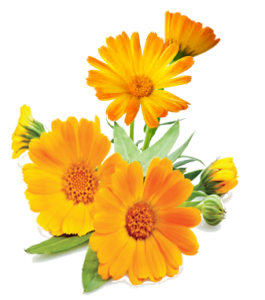Many readers of my newspaper columns have reported excellent results
for Crohn’s disease, colitis and inflammatory bowel disease after using the following recipe from an old German herbal book:
- 100g Calendula (Calendula officinalis)
- 50g Stinging nettle (Urtica dioica)
- 50g Yarrow (Achillea millefolium)
Mix all herbs into a bowl and then store them in a sealed glass jar away from sunlight. Prepare the tea as a hot infusion and drink 4-6 cups every day.
In addition, take one tablespoon of Swedish Bitters three times daily, ½ tablespoon before food and ½ tablespoon after food, with a little herb tea or water.
Calendula has antiseptic and antibacterial properties promoting healing.
 A cream or an ointment made of the flowers is an excellent first-aid for burns, bruises, sprains, sores, boils and bites. Nicholas Culpeper (1616-1654) states: “It is a good remedy for varicose veins, excellent for the circulation and so safe that its use can be indefinitely.”
A cream or an ointment made of the flowers is an excellent first-aid for burns, bruises, sprains, sores, boils and bites. Nicholas Culpeper (1616-1654) states: “It is a good remedy for varicose veins, excellent for the circulation and so safe that its use can be indefinitely.”
Calendula is a useful digestive remedy because it stimulates the flow of bile. Its anti-inflammatory properties prevent inflammation and promote healing in gastritis, enteritis and ulcers of the stomach. As a blood cleaner, it is a great help in infectious hepatitis.
In recent years the unique healing quality of calendula in cancer illnesses has been noted by many Europen and American physicians. Renowned Austrian herbalist Maria Treben writes: “If it is too late for an operation, the daily drinking of calendula tea for prolonged periods is recommended. The freshly pressed juice of the flowers can be used successfully, even in cancer of the skin, pigment spots, warts, scabies and cancer-like skin patches.”
Calendula also has anti-fungal properties which can help in the treatment of thrush (Candida albicans).
The name calendula is derived from the Latin calendulae, meaning throughout the months, a reference to the plant’s long flowering period. Other common names are Holigold, Garden marigold and Golds. The plant belongs to the compositae, a large family to which many herbs such as arnica, dandelion and chicory belong. Of many different species, calendula officinalis is used in herbal medicine.
It is a hardy self-seeding annual which will thrive in most soils, provided it is in a sunny position, and will grow to a height of 60cm with a spread of 60cm. Its hairy stem is erect and angular, the pale green leaves are alternate, sessile, spatulate or oblanceolate with widely spaced teeth.
The large orange or yellow flowers occur in terminal heads appearing in summer. Propagation is by seed sown in summer or autumn.
The plant flowers best in sunshine.
According to German fables, the weather can be predicted accurately by watching calendula flowers. If the flowers remain closed after 7am, rain is on the way, but if they open before 7am, the day will be fine. A Niewe Herbal of 1578 says: “It has pleasant, bright and shining yellow flowers, which do close at the setting downe of the sunne, and do spread open againe at the sunne rising.”
Get a better understanding of the powerful effect of herbal medicine and visit our Course Outline here. Choose from a variety of Lesson Packages and join us today!
